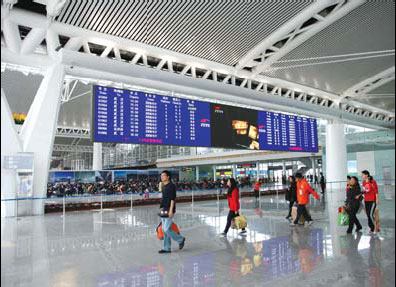Regional integration makes headway in Pearl River Delta
|
Guangzhou South Railway Station is a transportation hub linking cities in the Pearl River Delta. Regional integration in the delta has made transportation more convenient. Zou Zhongpin / China Daily |
Wang Jianhui, an associate professor at South China Normal University in Guangzhou, recently bought a new apartment in the city of Zhongshan, about 80 km away from where he works.
"I made my purchase decision for two key reasons: the house there is much cheaper than in Guangzhou, and the transportation is extremely convenient."
"I can either drive to my new house via the expressways or take the intercity light rail there."
Almost for the same reasons, many people who work in Guangzhou have chosen to buy houses in other Pearl River Delta cities outside Guangzhou and more people will follow suit, analysts said.
"The integration of the delta cities has brought about the improvement of traffic conditions. Otherwise, that would not have been possible," they said.
Guangdong began to promote regional integration in 2009 after gaining the approval of the State Council to implement the Outline of the Plan for the Reform and Development of the Pearl River Delta in late 2008.
"Great changes have in fact taken place, and the work of promoting regional integration is forging ahead right on track," according to a recent report released by the Guangdong Academy of Social Sciences.
According to the report, the nine Pearl River Delta cities form three economic circles. One covers Guangzhou, Fo-shan and Zhaoqing; the second is among Shenzhen, Dongguan and Huizhou, and the third is Zhuhai, Zhongshan and Jiangmen.
The three circles have signed a series of cooperative agreements to share public resources and services to jointly promote regional integration in varied sectors.
Guangzhou, Foshan and Zhaoqing have signed 55 cooperative agreements; Shenzhen, Dongguan and Huizhou, 49; and Zhuhai, Zhongshan and Jiangmen, 45. These agreements cover such areas of cooperation as environmental protection, infrastructure, urban and rural planning, industrial deployment and basic public services.
And integration of traffic-related infrastructure has made outstanding headway, according to the report.
The Guangzhou-Foshan intercity metro project and the Guangzhou-Zhuhai intercity light rail project as well as an improved expressway network have been put into service, and another 16 intercity light rails, with a total length of 1,478 km, are either under construction or will be built in the foreseeable future.
"Regional economic integration is market integration in essence," said Ding Li, director of the regional competitiveness research center under the provincial academy of social sciences.
"Market integration hinges heavily on the reform of the administrative system and the financial system, which the delta cities should do more in the future," he advised.
zhanlisheng@chinadaily.com.cn



















